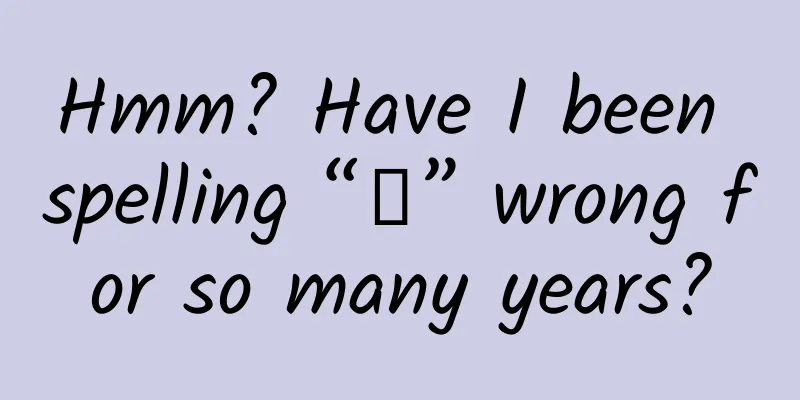Hmm? Have I been spelling “嗯” wrong for so many years?

|
In daily life and chatting, the word "嗯" is perhaps the most commonly used modal particle. On the Internet, "嗯" is even more commonly used by many people. When you type "嗯", what pinyin do you use? Recently, a parent discovered that he had typed "en" for 20 years, but his daughter's teacher taught her "ng". Reporters found that there are many adults who are confused like this. Is it because the textbooks have been revised, or has it always been like this? What is the pinyin of the word "嗯"? It's hard for parents How to pronounce the Chinese character "嗯" in Pinyin? Recently, Ms. Wang, who is teaching her preschool daughter to learn Pinyin, was confused. She told reporters that one day, her daughter was learning Pinyin according to a video course. When the teacher taught the word "嗯", the Pinyin writing caught her attention. She said: "For so many years, I have the impression that the pinyin for '嗯' is en, but the textbook marks it as ng, which makes me suspect that what I have learned all these years is wrong." Ms. Wang also asked her friends for advice. Everyone is unfamiliar with the pinyin "ng" and it takes them a while to think about how to pronounce it, while "en" is considered correct by everyone. △ Typing "en" can produce the word "嗯" △ The first choice for typing "ng" is the word "that" She said: "What confuses me most now is that my knowledge system is wrong when teaching children, and I don't know the reason." Ms. Wang also tried to find the answer on the mobile phone input method. "en" can output the word "嗯", and "嗯" is the first corresponding word by default in the input method. "ng" generally outputs the phrases "that", "which one", and "sad", but if you continue to select later, the word "嗯" will also appear. All three dictionaries say it is "ng", and the Chinese textbook compiled by the Ministry of Education also says it is "ng". On March 4, I checked several dictionaries at the Xinhua Bookstore in Xinjiekou. In the dictionaries, the pinyin of the word "嗯" is always "ng", and it has three tones. △The pinyin of "嗯" in the Xinhua Dictionary is also ng In the 12th edition of the Xinhua Dictionary edited by the Institute of Linguistics of the Chinese Academy of Social Sciences and published by the Commercial Press, if you search by pinyin, there are only three Chinese characters spelled as "en", namely "恩", "蒽", and " 摁". The pinyin of "嗯" is "ng", which has four pronunciations: second, third, and fourth. According to the interpretation, all three tones are interjections. When the second tone "ng" is pronounced, "嗯" expresses doubt, the third tone expresses disapproval or surprise, and the fourth tone expresses agreement. △ The pinyin of "嗯" in the Modern Chinese Dictionary is ng. In the 7th edition of the Modern Chinese Dictionary edited by the Dictionary Editorial Office of the Institute of Linguistics of the Chinese Academy of Social Sciences and published by the Commercial Press, there are four Chinese characters spelled as "en", namely "奀", "恩", "蒽", and " 摁", and there is no "嗯" with the character "口". The pinyin of "嗯" is also "ng", which has three pronunciations. △The pinyin of "嗯" in Xinhua Dictionary is ng In the third edition of the Xinhua Dictionary, in addition to the basic pinyin and meaning, an analysis of the origin of the word is added, which states: "嗯" is a pictophonetic character, with "口" as the shape and "恩" as the sound. It has three different pronunciations, and its meanings are also different. When it is pronounced as the second tone "ńg", it means questioning; when it is pronounced as "ňg", it means disapproval; when it is pronounced as "ǹg", it means agreement, all of which are interjections. So how is this spelling taught in current textbooks? He Xin, a Chinese teacher at the primary school of Nanjing Jinling Middle School Hexi Branch, told reporters that in primary school Chinese teaching, the word "嗯" appears in the text. In the current Ministry-edited Chinese textbooks, the pinyin for "嗯" is indeed "ng". Except for "嗯", did you spell the pinyin of these words correctly? I found that Ms. Wang's confusion is not an isolated case. Many netizens asked online what the correct pinyin for "嗯" is. In addition, netizens also summarized some marginal sounds that are in an "awkward" position, such as "哄", "噷", "咔", "哟", and "覅". The correct pinyin for "哄" should be "hng", but the current input method uses the pinyin "heng", and "hng" cannot be typed as "哄". However, "咔" and "哟" can be correctly output through the pinyin "lo" and "yo". In fact, these characters are marginal sounds in Chinese, and are special pronunciations of Chinese characters, such as ng, n, m. The correct pinyin for "姆" should be "m", but it is now commonly used as "mu". After the emergence of the Internet and pinyin input methods, many marginal Chinese characters have evolved in use. In this regard, some netizens suggested whether the pinyin of marginal Chinese characters can be modified in a popular way, which can avoid confusion and facilitate teaching, so that children can be consistent in use and learning. What do you think about this? Welcome to leave a message to share your views. Old rules Feeling knowledgeable Repost and like 👍 |
Recommend
What other “superpowers” can quantum computing demonstrate?
Quantum computing is getting closer and closer to...
Dismantling the entire process of Yuanqi Forest's layout of private domain
Purpose of case analysis: The number of followers...
"Losing weight" is a big deal! These 6 wrong ways to lose weight may ruin you
Being fat may sound like a trivial matter, but it...
Technology and hard work? Can you eat hot pot meatballs safely?
As the weather gets colder, many people fall in l...
A large wave of spam animations is coming
Source code introduction: Compared with the previ...
Why is the CPU frequency of Xiaomi 5, which costs 1999 yuan, so low?
The three versions of Xiaomi 5 all have the same ...
Snowden says US government hacked global mobile networks
Documents from Edward Snowden released by The Int...
What happened with Remington filing for bankruptcy? Why did Remington file for bankruptcy?
Remington files for bankruptcy Remington, an Amer...
Analysis of Pinduoduo’s marketing activities!
I think everyone is familiar with the product Pin...
The doctor said: Don’t do these 4 things, otherwise you will have another cerebral infarction!
Master Li had another cerebral infarction. This w...
I have little education, don’t lie to me, does Android development make more money?
With the rapid development of mobile devices, use...
In addition to fish and meat, I sincerely advise you to eat less of these things during the Chinese New Year.
The New Year is coming soon. After being busy out...
Practical review: How to build a complete operation system?
This article is a review of my recent practice. T...
The “20-minute park effect” has become popular, but what do you do in the park?
The “20-minute park effect” has become popular. T...
How to set keywords for Xiaohongshu promotion notes!
On the Xiaohongshu platform, taking good notes is...









